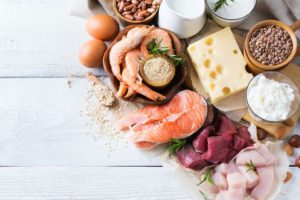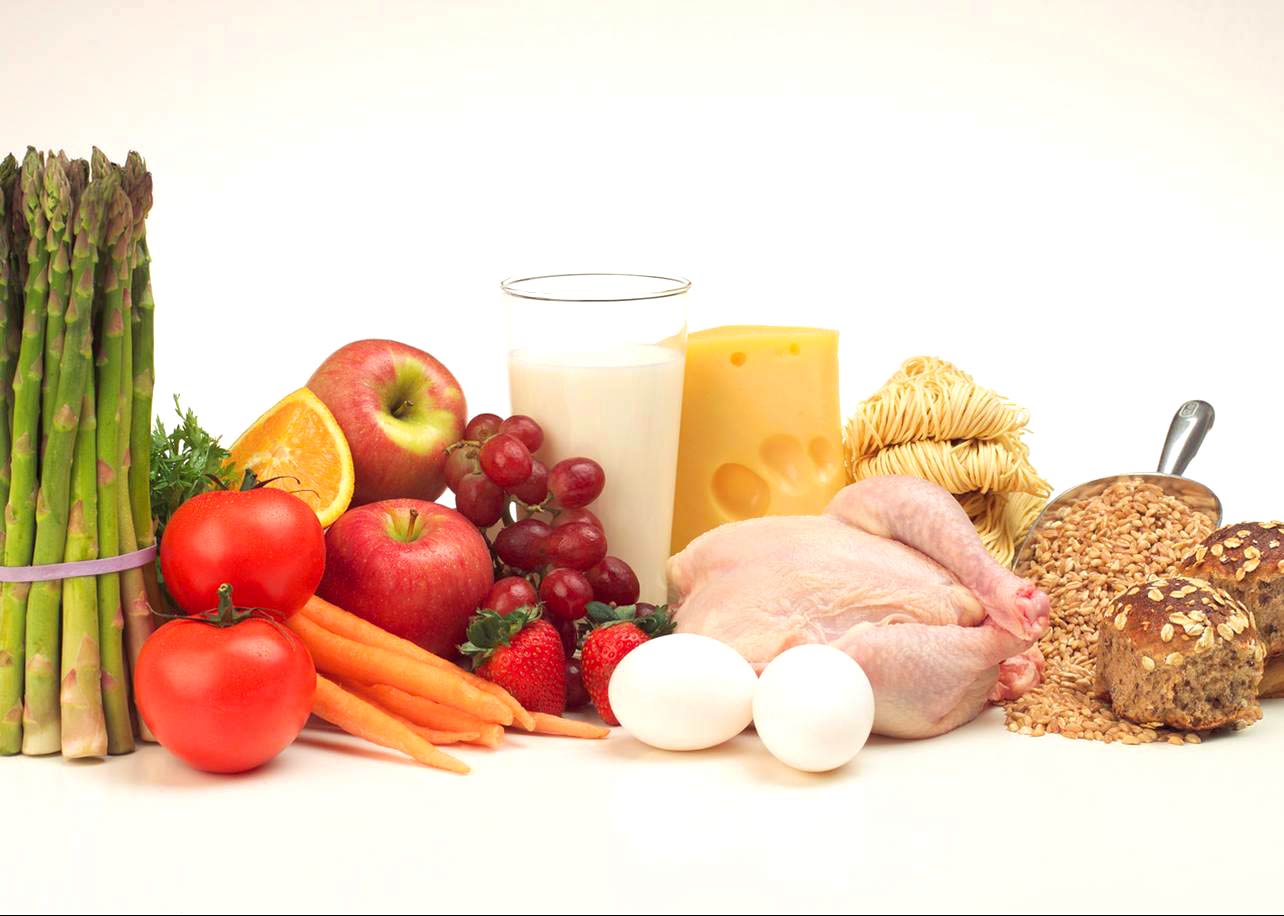Macronutrients
Nutrients are substances needed for growth, metabolism, and for other body functions. Macronutrients are nutrients that provide calories or energy. The prefix macro is from the Greek and means big or large, used because macronutrients are required in large amounts.
There are 3 broad classes of macronutrients:
- Proteins
- Carbohydrates
- Fats
The primary function of macronutrients is to provide energy, counted as calories. While each of the macronutrients provides calories, the amount contributed by each varies.
- Carbohydrates provide 4 calories per gram.
- Protein provides 4 calories per gram.
- Fat provides 9 calories per gram.
Macronutrients also have specific roles in maintaining the body and contribute to the taste, texture, and appearance of foods, which helps to make the diet more varied and enjoyable.
Proteins
Proteins, from the Greek proteios meaning “first,” are important biological molecules that consist of strings of smaller units called amino acids, the “building blocks” of proteins. These amino acids are linked together in sequence as polypeptide chains that fold into compact shapes.
Besides providing energy to the body, dietary protein is also required for growth—especially by children, teenagers, and pregnant women, tissue repair, immune system function, hormone and enzyme production, and for lean muscle mass and tone maintenance. When eaten, the proteins contained in foods are broken down into amino acids, an important dietary source of nitrogen.
There are 20 amino acids and the body can make some of them from components within the body, but it cannot synthesize nine of them, accordingly called the “essential amino acids” since they must be provided in the diet. They include histidine, isoleucine, leucine, methionine, phenylalanine, threonine, tryptophan, and valine.
A protein that comes from animal sources is called “complete proteins” because they contain all of the essential amino acids while protein from plants, legumes, grains, nuts, seeds and vegetables are called “incomplete proteins” because they lack one or more essential amino acid(s).
Proteins are complex molecules and the body needs time to break them down. This is why they are a slower and longer-lasting source of energy than carbohydrates. Adults who are physically very active or trying to build muscle need slightly more. Children also need more. If more protein is consumed than is required, the body stores its components as fat, which can be broken down and used for energy as the need arises. Proteins are broken down during digestion, which exposes them to acid in the stomach and to degradation by the action of enzymes called proteases. Some ingested amino acids are converted to carbohydrates, which is also used under starvation conditions to generate glucose from the body’s own proteins, particularly those found in muscle.
 Foods that are a source of protein include:
Foods that are a source of protein include:
- Beef
- Pork
- Poultry
- Fish
- Eggs
- Milk
- Cheese and yogurt
- Nuts
- Seeds
Plant proteins: Plants, legumes, grains, nuts, seeds and vegetables provide low biological value proteins. However, combining proteins from different plant sources in the same meal often results in a mixture of higher biological value. Examples of such combinations are beans with rice, pasta or manioc, chickpeas with bread, lentils with potatoes, vegetables with cereals.
Carbohydrates
There are two basic types of carbohydrates, depending on their size. Simple carbohydrates (monosaccharides) are those that cannot be broken down into simpler sugars. They include various forms of sugar, such as glucose and fructose. Complex carbohydrates are more significant and consist of long strings of simple carbohydrates (disaccharides, oligosaccharides, polysaccharides). They include sucrose, lactose, maltose, maltodextrins, fructo-oligosaccharides, starch, amylose, and amylopectin.
The human body uses carbohydrates in the form of glucose and it can convert both simple and complex carbohydrates into energy very quickly. The brain needs to use glucose as an energy source since it cannot use fat for this purpose. This is why the level of glucose in the blood must constantly be maintained above the minimum level. The body also stores minimal amounts of excess carbohydrate as the energy reserve. The liver stores some as glycogen, a complex carbohydrate that the body can easily and rapidly convert to energy. Muscles also store glycogen, which they use during periods of intense physical activity. A number of carbohydrates stored as glycogen is equivalent to about a day’s worth of calories. A few other body tissues store carbohydrates as complex carbohydrates that cannot be used to provide energy.
Carbohydrates have two significant roles: they are the primary energy source for the brain and they are a source of calories to maintain body weight. A diet containing an optimum level of carbohydrates may help prevent body fat accumulation. They are also involved in the construction of the body organs and nerve cells, and in the definition of a person’s biological identity such as their blood group. Dietary fiber, which is a carbohydrate, also helps keep the bowel functioning properly. Because they are smaller, simple carbohydrates can be broken down by the body more quickly and they are the fastest source of energy. Fruits, dairy products, honey, and maple syrup contain significant amounts of simple carbohydrates, which provide the sweet taste in most candies and cakes.
Complex carbohydrates also include starch, the primary energy reserve in root vegetables and cereals. Non-starch carbohydrates are the main components of dietary fiber. These are the indigestible portion of plant foods, such as cellulose, the primary component of plant cell walls that consists of several thousand glucose units. Simple sugars are absorbed directly by the small intestine into the bloodstream, where they are then transported to where they are required. Complex carbohydrates are broken down by enzymes into their constituent sugars which are then absorbed into the bloodstream while dietary fiber moves food through the digestive system.
Sources of dietary carbohydrates include:
- Monosaccharides: fruits, berries, vegetables, and honey.
- Disaccharides: table sugar, sugar beet, sugar cane and fruits.
- Polyols: Isomalt
- Oligosaccharides: grains and vegetables
- Starch polysaccharides: cereals, whole grains, rice, pasta, potatoes, peas, corn and legumes.
- Non-starch polysaccharides: dietary fiber such as cellulose, hemicelluloses, pectins, and gums.
Fats
Besides being a source of energy, fat stores protect the internal organs of the body. Some essential fats are also required for the formation of hormones. Fats are the slowest source of energy but the most energy-efficient form of food. Each gram of fat supplies the body with about 9 calories, more than twice that provided by the two other macronutrients. Because fats are such an efficient form of energy, they are stored by the body either in the abdomen or under the skin for use when the body needs more energy.
Fats that are in foods are combinations of 4 main types:
- Saturated fats:These fats consist of fatty acid chains that have no double bonds between the carbon atoms of the chain. They are called saturated because they are fully saturated with hydrogen atoms and cannot incorporate more. They are solid at room temperature and are most often of animal origin. Examples are butter, cheese, and lard. These fats provide a concentrated source of energy in the diet and building blocks for cell membranes and a variety of hormones and hormone-like substances. An excess of these fats in the diet, however, is believed to raise the cholesterol level in the bloodstream.
- Monounsaturated fats:These are composed mostly of monounsaturated fatty acids, meaning molecules with one double-bonded carbon, with all the others carbons being single-bonded. They are liquid at room temperature. Examples are olive, peanut and canola oil. They appear to protect against heart disease, in that they reduce blood cholesterol levels.
- Polyunsaturated fats: These fats are composed mostly of fatty acids such as linoleic acids which have two or more double bonds in each molecule, like corn oil and safflower oil. They are also liquid at room temperature and can be further divided into the omega-6 and the omega-3 families. Polyunsaturated fats are thought to reduce the risk of coronary heart disease. The omega-3 forms are believed to have a positive impact on heart health and to play an important role in brain and eye function. Oily fish such as salmon, herring, and mackerel are examples of omega-3s, and they are also found in walnuts and some oils like soybean and grapeseed.
- Trans fatty acids:Unsaturated fats come in different chemical structures and when they adopt the transform, they are called trans fatty acids. They are produced by the partial hydrogenation of vegetable oils and present in hardened vegetable oils, most margarine, commercial baked goods, and many fried foods. An excess of these fats in the diet is thought to increase the risk of heart disease.
[progressally_complete_button text=’Mark As Done’ objective_id=’all’]
[accessally_has_any_tag tag_id=’1038255′ comment=’Micronutrients_tag’]
[accessally_course_navigation prev_button=’Previous’ next_button=’Next’]
[/accessally_has_any_tag]


You must be logged in to post a comment.